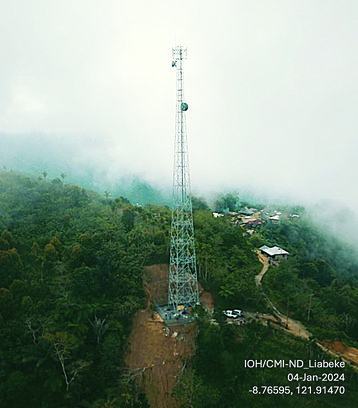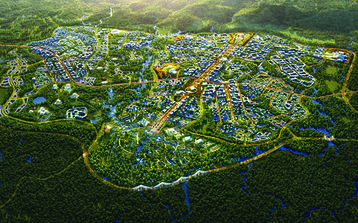The biggest opportunity from the merger has been to serve more rural customers,” Vikram Sinha, CEO of Indosat, tells DCD.
In 2022, two Indonesian telcos, Ooredoo Indosat and Hutchison Asia Telecom Group merged to create Indosat Ooredoo Hutchison (IOH), a combined company worth $6 billion (IDR97.7tn).
Sinha, who was installed as the CEO of the new business following the merger, insists it has been a success for the company, which serves more than 100 million mobile subscribers and is Indonesia’s second-largest telco.
He explains that the merger has enabled Indosat to plug gaps in its network coverage, in particular in rural parts of the country.
“Currently, we are strong in Java, but the biggest opportunity for growth comes from rural Indonesia,” says Sinha. “We are really focused on improving the customer experience in these areas. In 2023, Indosat invested around $800 million (IDR13bn) in capital expenditure, around 60 percent of this being spent to strengthen our network in rural Indonesia. We are continuing this investment in 2024.”
He says the merger has enabled the telco to vastly increase its network coverage, plugging gaps where coverage hadn’t previously been. At present, Indosat’s mobile network covers 94 percent of the country’s population.
By 2027, Indosat plans to connect 21 million rural residents to Internet and mobile services, as part of this investment.
Proving mergers can succeed
Mergers are often controversial as they can be perceived to hinder competitiveness in the market.
It was no different for Indosat at first, explains Sinha, who notes that credit rating agency Fitch Ratings downgraded the company to a negative BBB rating after the deal closed in 2022.
However, two years later the same agency has since upgraded Indosat to a positive score of AA+.
In the case of Indonesia, a country that boasts a population of around 280 million people, there’s plenty of competition, with networks including Telkom Indonesia, the country’s biggest telco, XL Axiata, and Smartfren Telecom all fighting for customers. The latter two are currently in talks over a merger of their own.
But Sinha, who previously led Ooredoo Indosat’s operations in Myanmar and the Maldives, argues that the merger between Ooredoo Indosat and Hutchison Asia Telecom Group was necessary for the Indonesian market.
“We have achieved around $400m (IDR6.5bn) in annualized synergies, or cost savings, due to the merger. We have already completed most of the big-ticket integration initiatives, mainly around network integration, but there is still more we can do,” says Sinha.
He adds that the main focus of the company since merging has been around optimizing its business.
“This is reflected in our network integration, which we completed in record time in around 12 months. Where there was overlap in the two networks and duplicate transmission sites, we could remove some sites to achieve cost savings.”
Sinha says Indosat has been able to do this by strengthening its network in parts of rural eastern Indonesia where there were gaps.
“By removing duplicate sites and rolling out new sites in new areas we have managed to reduce our total number of sites delivering cost savings while improving the experience for our customers,” he explains.
4G push
In its most recent earnings for the first quarter of this year, Indosat reported revenue growth of $873m (IDR13.8 billion), up 15.8 percent, while net profits jumped nearly 40 percent year-on-year (YoY).
Significantly, it grew its total subscriber base beyond 100 million customers during the period, which Sinha attributed to the company’s increased focus on rural areas.
In total, Indosat increased its customer base by 2.3 percent YoY during the first quarter.
“We have been investing significantly in building a very high-quality network in the rural parts of Indonesia. Indosat must have a competitive network not only in Java, but it has a very reliable and competitive network across Indonesia,” Sinha says.
"In rural areas, 4G device penetration is still much higher than for 5G, and so we are focusing on expanding and strengthening our 4G network.”
Indeed, since last year Indosat has pledged to invest around 60 percent of the money it puts into its capex programs into rural areas.
However, because Indonesia is made up of around 17,500 islands, of which around a third (6,000) are inhabited, getting to every inch of the country is impossible, due to the terrain in these locations, coupled with the fact that the majority of the islands are uninhabited, and therefore do not require network coverage.
In addition, the vast number of islands means it costs Indosat more to expand its networks.
“The cost of network expansion and enhancement is high in Indonesia because the country is made up of so many islands and the population density is quite low in areas,” explains Sinha. “This means the number of people covered by base stations is lower than in urban Europe, for example.
“Another challenge is transport and making sure we have a resilient transport network at the right price,” Sinha adds. “We need to build our network and sales channel capabilities in rural areas, and we need to be able to travel at a reasonable cost. We always need to be mindful that we operate in a market with a monthly average revenue per user of around $3.”
To date, the network build-out has focused heavily on 4G connectivity too, according to Sinha. This has been reflected in the company’s recent earnings report, which revealed that its 4G base station footprint grew by more than 20 percent to 184,000 across the country. Data traffic across its 2G, 4G, and 5G networks rose by 14.3 percent year-on-year, to 3,858PB.
Like many operators across the globe, Indosat has phased out its 3G network, doing so back in 2021, well before many of the world’s markets.
“3G was a waste of allocation of spectrum, so we were very quick to do that,” he explains, with the move freeing up spectrum in the 1,800 to 2,100 MHz bands.
He notes that the company still operates its 2G network and says it has between five and six million 2G users. There is no timeline for when it will retire this network.
No rush with 5G
Many markets across the world, in particular in Western Europe, the US, South Korea, and Japan battled for supremacy in the race to launch 5G networks.
While South Korea and Switzerland launched their first 5G commercial networks in early 2019, the same wasn’t happening in Indonesia.
Indosat launched 5G in 2021. Its 5G network is available in eight cities, including Jakarta, Surakarta, and Denpasar, Bali.
Even now, Sinha says it’s taking its time with expanding its 5G rollout, insisting it’s never been a race to launch the latest G.
“I think for Indonesia, it was a wise decision not to rush on 5G, as we have seen from all over the world that sometimes being late is good,” he says. 5G is not about speed but is about the whole ecosystem getting ready.
“In the case of 5G, it’s not about being first. It’s about ensuring that the complete ecosystem of handsets, applications, and use cases is ready so that customers see the benefits of the technology and we can see a return on our investment. The key thing is when we put money on 5G, we should be equally ready to monetize our investment otherwise it will have no meaning. If the use cases for 5G aren’t there, then you don’t have that.”
Sinha adds that Indosat’s network is “fully modernized,” and ready for upgrades as soon as certain 5G spectrum comes into play.
He touts benefits such as faster connection speeds and the potential for the technology to drive Industry 4.0, while Fired Wireless Access (FWA) also excites Sinha.
Building Indonesia’s new capital
One of the company’s biggest endeavors at present is its role in the build-out of Indonesia’s new capital city, Nusantara, which is set to begin this summer.
Nusantara is being built on the island of Borneo, 800 miles away from the current capital Jakarta on the island of Java. With a population of 34 million, Jakarta is already overcrowded, and is threatened by severe rainfall that could leave it underwater by 2050.
Indonesia's President Joko Widodo plans to build an entirely new "green" capital by clearing virgin rainforest on Borneo, and has decreed that, on 17 August 2024, the role of the capital city will shift to what is currently a vast building site.
This is no small task, and to support the move, Indosat is developing a 4G LTE network for the city, says Sinha.
He explains that around $10m (IDR162.9bn) has so far been invested to deploy between 30 to 40 base transceiver stations in Nusantara, on top of the 30 4G sites it already operates in the area.
“[In Nusantara] we will be working very closely with the authorities to ensure that there is world-class digital infrastructure," he said in August of last year.
“Indosat’s wider purpose is to empower Indonesia and so we are working very closely with the authorities to help develop world-class digital infrastructure in the Nusantara area. The work has already started, and we are doing it in a very collaborative manner. We already have around 30 transmission sites in the area, and we recently invested another $10m to add another 30 to 40 new sites.”
The move to switch capitals is estimated to cost $30bn (IDR466tn).
Spin in it to win it
As is the case with many telcos, Indosat doesn’t just own traditional telecom assets, it also owns a data center business.
In 2022, it teamed up with BDx Data Center, and Lintasarta to form a data center joint venture (JV). The agreement, valued at the time at around $300m (IDR4.8tn), marked BDx’s entry into the Indonesian data center market. The companies said the JV was formed to “meet Indonesia’s growing need for a higher level of global data center facilities.”
Earlier this year, Indosat agreed to sell a portfolio of data centers to BDx, consisting of carrier-neutral colocation and Edge sites in cities such as Jakarta, Surabaya, Batam, Medan, Makassar, Bandung, and Semarang, including ten sites connected to six domestic and five international subsea cables.
“We're honored to play a role in shaping Indonesia's digital future through this impactful collaboration,” Sinha commented in January. “This transaction underscores our dedication to building a sustainable business and propelling Indosat's evolution from telco to TechCo. Collaborating with BDx Indonesia not only enhances our customer service but also reinforces our commitment to connecting and empowering every Indonesian.”
Providing an update on the company’s approach to its data center assets, Sinha told DCD that it made more sense to focus on areas where it had more expertise.
“We decided to carve out data centers. So it was not only about money, it was more about getting the right expertise, supported by the right funds needed, and that's why we created this JV with BDx.
“We wanted to create a platform which had all the right expertise and that can help fulfill the needs of Indonesia when it comes to data centers.”
However, it’s not just data center assets that Indosat has sold, the company has also turned its attention to monetizing its telecom towers, something that has been seen frequently in the telecom industry in the past few years.
The company completed the sale of 4,200 telecom towers to DigitalBridge-owned EdgePoint Infrastructure's Indonesian unit in 2021 for $750m (IDR12.2tn). Last year, Indosat scooped an additional $109m (IDR1.75bn) following the sale of 997 towers to Mitratel.
Sinha has not ruled out any further tower sales, noting that any proceeds contribute towards the modernization of its mobile network.
“We want to be asset right and asset-light,” he says. “With towers, we did it for the right reason, so that our focus is we build competencies that are focused on our strengths. When it comes to infrastructure, we want to make sure that it is carved out, so that we can unlock the full potential of its value.”
Sinha also revealed that Indosat is set to add between 2,500 to 3,000 new towers this year, as it aims to plug coverage gaps across the country.
Indosat has been heavily rumored to be considering selling its fiber assets, which could fetch as much as $1bn (IDR16.2tn). Sinha didn’t comment on the deal, simply noting that Indosat is open to the right deal.
In November, the company confirmed the acquisition of fiber-based service provider MNC Kabel Mediacom (MNC Play) in Indonesia as part of a collaboration with Asianet.
“In the area of fiber-to-the-home (FTTH), I expect our home broadband business, which we call Indosat HiFi, to become an increasingly important contributor to Indosat’s growth in the future,” he adds.
All eyes on an AI future
As with every other business, the company is still trying to work out how AI will impact its growth.
“Indosat has a larger purpose, to connect and digitally empower every Indonesian,” he explains. “AI can play a pivotal role in advancing Indonesia by unleashing the innovation and creativity of Indonesian businesses.”
Such is the company’s optimism around AI, it announced a partnership with GPU maker Nvidia to build an AI center in Surakarta, Indonesia.
The center will be worth about $200m (IDR3.2tn) and could also include telecommunications infrastructure and a human resource center, while Sinha says it’s part of Indosat’s strategy to become an AI pioneer in the country.
“Through our landmark partnership with Nvidia to become their cloud provider partner in Indonesia, we will democratize access to AI-cloud services, making them accessible to businesses across Indonesia and the region, and accelerating the growth of Indonesia’s digital economy,” he adds.
The CEO believes AI will be “transformative in helping productivity,” and adds: “There’s been a lot of fear that AI will replace jobs, but this isn’t the case. It will replace people who don’t embrace the technology.”
His enthusiasm for the technology mirrors that of many in the telecoms industry. Only time will tell as to how pivotal AI will be in the future for telcos such as Indosat.
But, for now, the main focus is on bridging the gap between Jakarta and some of the country’s more rural communities.
“Whether someone is in Jakarta or in places like Lombok, or Nusantara, we want them to have the same level of experience. That is our goal, that is the journey we are now on by investing in our network.”




